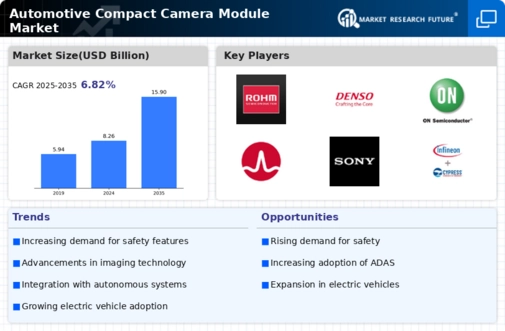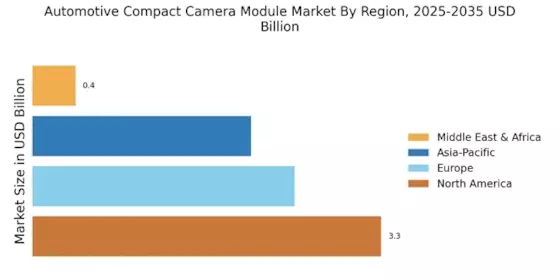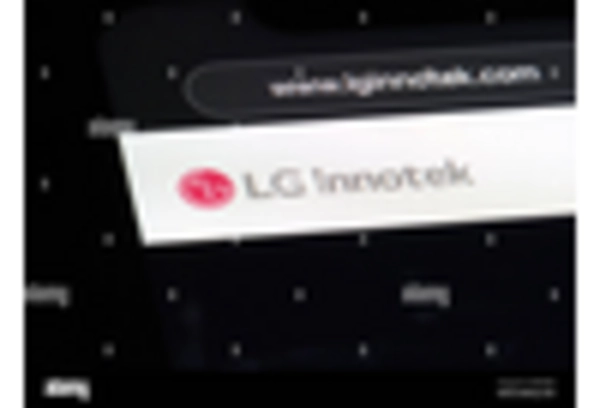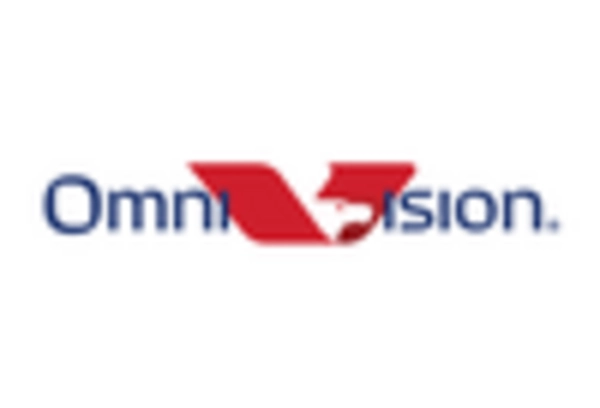Growth of the Electric Vehicle Market
The growth of the electric vehicle (EV) market is emerging as a significant driver for the Automotive Compact Camera Module Market. As the adoption of EVs continues to rise, manufacturers are increasingly incorporating advanced camera systems to enhance safety and functionality. Market Research Future indicates that the EV market is expected to grow at a CAGR of 25% over the next decade, leading to a corresponding increase in demand for compact camera modules. These modules are essential for features such as parking assistance, collision avoidance, and enhanced visibility. As automotive companies strive to differentiate their EV offerings, the integration of sophisticated camera systems becomes a key focus. Thus, the Automotive Compact Camera Module Market is likely to experience robust growth, fueled by the expanding electric vehicle segment.
Government Initiatives Promoting Vehicle Safety
Government initiatives aimed at promoting vehicle safety are significantly influencing the Automotive Compact Camera Module Market. Various countries are implementing stricter regulations regarding vehicle safety standards, which often necessitate the incorporation of advanced camera systems. For instance, regulations mandating rearview cameras in all new vehicles have already been enacted in several regions. This regulatory push is expected to drive the market for compact camera modules, as manufacturers seek to comply with these safety requirements. Data indicates that the market for automotive safety systems, including camera modules, is projected to grow at a CAGR of 12% over the next five years. Consequently, the Automotive Compact Camera Module Market stands to gain from these regulatory developments, as they create a favorable environment for innovation and investment.
Increasing Demand for Advanced Driver Assistance Systems
The Automotive Compact Camera Module Market is experiencing a surge in demand for advanced driver assistance systems (ADAS). This trend is largely driven by the growing emphasis on vehicle safety and the need to reduce road accidents. According to recent data, the ADAS market is projected to grow at a compound annual growth rate (CAGR) of approximately 10% over the next five years. As a result, automotive manufacturers are increasingly integrating compact camera modules into their vehicles to enhance functionalities such as lane departure warning, adaptive cruise control, and parking assistance. This integration not only improves safety but also aligns with consumer expectations for high-tech features in modern vehicles. Consequently, the Automotive Compact Camera Module Market is likely to benefit from this heightened focus on safety and technology.
Rising Consumer Preference for Enhanced Vehicle Features
Consumer preferences are shifting towards vehicles equipped with advanced features, which is propelling the Automotive Compact Camera Module Market. As consumers become more tech-savvy, they increasingly seek vehicles that offer enhanced functionalities such as 360-degree cameras, night vision, and high-definition imaging. Market data indicates that the demand for vehicles with integrated camera systems is expected to rise significantly, with a projected increase of 15% in the next few years. This trend is further fueled by the growing popularity of electric and hybrid vehicles, which often come equipped with state-of-the-art technology. As manufacturers strive to meet these evolving consumer demands, the Automotive Compact Camera Module Market is poised for substantial growth, driven by the need for innovative camera solutions.
Integration of Artificial Intelligence in Automotive Systems
The integration of artificial intelligence (AI) into automotive systems is emerging as a pivotal driver for the Automotive Compact Camera Module Market. AI technologies enhance the capabilities of camera modules by enabling features such as real-time image processing, object recognition, and predictive analytics. This integration not only improves the functionality of existing systems but also paves the way for new applications in autonomous driving. Market analysts suggest that the AI segment within the automotive industry could witness a growth rate of around 20% in the coming years. As automotive manufacturers increasingly adopt AI-driven solutions, the demand for compact camera modules that can support these advanced technologies is likely to escalate, thereby propelling the Automotive Compact Camera Module Market forward.


















Leave a Comment